
In today’s world, the quality of the air we breathe indoors is becoming an increasing concern. While we often think of pollution as an outdoor issue, the air inside our offices and commercial spaces can harbour a cocktail of unwelcome compounds. Thankfully, nature offers a stylish solution: houseplants. Beyond their aesthetic appeal, certain green companions have been shown to possess air-purifying qualities, helping to create healthier and more vibrant environments.
While the extent of their impact in everyday settings is a topic of ongoing discussion, the potential benefits, coupled with their undeniable visual charm and positive impact on well-being, make them a worthwhile addition to any professional space. Let’s explore ten fantastic houseplants that can help you breathe a little easier.
Snake Plant (Sansevieria trifasciata)
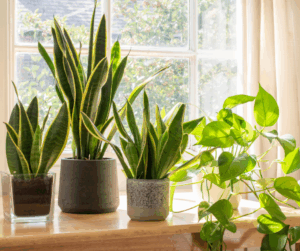
Also known as Mother-in-Law’s Tongue, the Snake Plant is a striking and remarkably resilient choice for busy environments.
Air-Purifying Capabilities: The Snake Plant is recognised for its ability to filter out formaldehyde, benzene, trichloroethylene, xylene, and toluene. It’s also unique in its ability to release oxygen at night, making it a beneficial presence even when the lights are out.
Other Benefits: This architectural plant is famed for its low maintenance needs, thriving on neglect and tolerating low light conditions. Its upright, sword-like leaves add a touch of modern elegance to any setting.
Care Guide: Water sparingly, allowing the soil to dry out completely between waterings. Snake Plants prefer indirect light but can adapt to low light and even some direct sun. Average room temperatures are ideal.
Potential Downsides: Mildly toxic if ingested, so consider placement if pets or young children are present.
Urban Planters’ Touch: The Snake Plant’s strong vertical lines make it a fantastic feature in contemporary office designs, particularly when showcased in tall, slender planters. Its adaptability to various light levels makes it a versatile choice for different areas within a commercial space.
Spider Plant (Chlorophytum comosum)
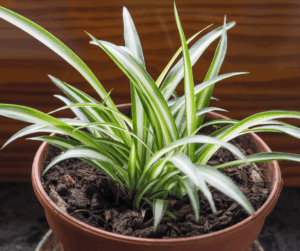
With its arching foliage and trailing plantlets, the Spider Plant brings a touch of natural dynamism to interiors.
Air-Purifying Capabilities: Spider Plants are effective at removing formaldehyde, xylene, and carbon monoxide from the air. They are also considered one of the easier air-purifying plants to grow.
Other Benefits: These adaptable plants are relatively low-maintenance and produce numerous “spiderettes” which can be easily propagated, making them a cost-effective way to increase greenery.
Care Guide: Spider Plants prefer bright, indirect light but can tolerate lower light levels. Water regularly, keeping the soil consistently moist but not waterlogged. Brown tips can sometimes occur due to tap water; using filtered water may help.
Potential Downsides: Non-toxic to pets, making them a safer option for animal lovers.
Urban Planters’ Touch: Spider Plants look fantastic in hanging baskets or elevated planters, allowing their cascading foliage to create visual interest. Their air-purifying qualities make them a welcome addition to workspaces where air quality might be a concern.
Pothos (Epipremnum aureum)
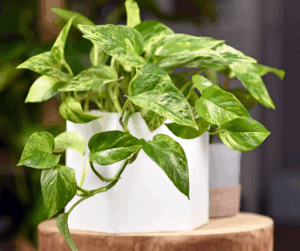
Also known as Devil’s Ivy or Golden Pothos, this vine is a popular choice for its attractive, heart-shaped leaves and ease of care.
Air-Purifying Capabilities: Pothos is effective at filtering out formaldehyde, benzene, and trichloroethylene. It’s a reliable and readily available air-purifying option.
Other Benefits: Pothos is incredibly adaptable and can thrive in a variety of conditions, including low light. Its trailing nature makes it ideal for shelves, desks, and hanging baskets.
Care Guide: Pothos prefers bright, indirect light but can tolerate low light. Allow the top inch of soil to dry out between waterings. It’s a relatively forgiving plant for those new to indoor gardening.
Potential Downsides: Toxic if ingested, so keep away from pets and small children.
Urban Planters’ Touch: Pothos is a versatile plant that can be used to add a touch of green to various office areas. It can be trained to climb or allowed to trail from shelves and cabinets, adding a natural, flowing element to the workspace.
Peace Lily (Spathiphyllum)
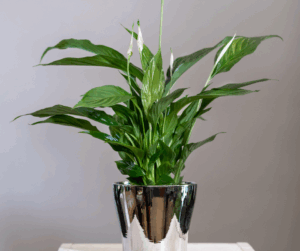
With its elegant white blooms and glossy green leaves, the Peace Lily brings a sense of tranquility to any interior.
Air-Purifying Capabilities: Peace Lilies are known for their ability to filter out formaldehyde, benzene, trichloroethylene, xylene, and ammonia. They can also help to increase humidity in the air.
Other Benefits: Their striking white flowers add a touch of sophistication to office environments. They are also relatively easy to care for, though they will dramatically droop to signal when they need watering.
Care Guide: Peace Lilies prefer low to medium indirect light. Keep the soil consistently moist but not waterlogged. They appreciate higher humidity, so occasional misting can be beneficial.
Potential Downsides: Mildly toxic if ingested and their pollen can be irritating to some individuals.
Urban Planters’ Touch: The elegant appearance of Peace Lilies makes them ideal for reception areas and meeting rooms, adding a touch of calm and sophistication. Their air-purifying qualities contribute to a more welcoming and healthy environment for both staff and visitors.
Chinese Evergreen (Aglaonema)
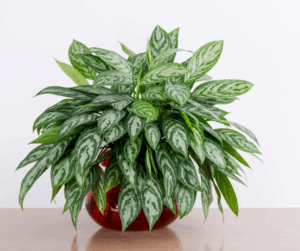
With its diverse foliage patterns and colours, the Chinese Evergreen is a visually appealing and easy-to-care-for plant.
Air-Purifying Capabilities: Chinese Evergreens are effective at filtering out formaldehyde and benzene. They are also known for their ability to tolerate low light conditions.
Other Benefits: These plants come in a variety of attractive leaf patterns and colours, adding visual interest to interiors. They are also relatively low-maintenance and can tolerate some neglect.
Care Guide: Chinese Evergreens thrive in low to medium indirect light. Allow the top inch of soil to dry out between waterings. They prefer warmer temperatures and higher humidity.
Potential Downsides: Slightly toxic if ingested, so caution should be taken with pets and young children.
Urban Planters’ Touch: The variety in leaf colour and pattern makes Chinese Evergreens a versatile choice for adding visual interest to different office zones. Their tolerance of low light makes them suitable for areas with limited natural light.
Heartleaf Philodendron (Philodendron hederaceum)
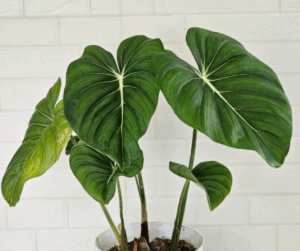
With its glossy, heart-shaped leaves and trailing vines, the Heartleaf Philodendron is a classic and easy-to-grow houseplant.
Air-Purifying Capabilities: Heartleaf Philodendrons are effective at filtering out formaldehyde. They are a reliable and attractive option for improving indoor air quality.
Other Benefits: These plants are incredibly adaptable and can thrive in a wide range of conditions, including low light. Their trailing nature makes them perfect for hanging baskets and shelves.
Care Guide: Heartleaf Philodendrons prefer bright, indirect light but can tolerate low light. Allow the top inch of soil to dry out between waterings. They are relatively low-maintenance and forgiving.
Potential Downsides: Toxic if ingested, so keep away from pets and young children.
Urban Planters’ Touch: The Heartleaf Philodendron’s lush, trailing foliage adds a touch of natural beauty to office spaces. It can be used to soften harsh lines and create a more inviting atmosphere.
Rubber Plant (Ficus elastica)
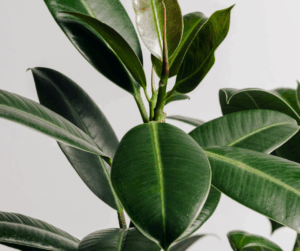
With its large, glossy leaves, the Rubber Plant makes a bold and stylish statement in any interior.
Air-Purifying Capabilities: Rubber Plants are effective at filtering out formaldehyde. Their large leaves also help to increase humidity.
Other Benefits: These plants are relatively easy to care for and their large, dramatic foliage adds a touch of tropical elegance to office environments.
Care Guide: Rubber Plants prefer bright, indirect light. Allow the top inch of soil to dry out between waterings. Wipe the leaves occasionally to remove dust and maintain their shine.
Potential Downsides: The milky sap can be irritating to some individuals and the plant is toxic if ingested.
Urban Planters’ Touch: The Rubber Plant’s bold presence makes it an ideal focal point in larger office spaces or reception areas. Its air-purifying qualities and striking appearance make it a valuable addition to a healthy and stylish workplace.
Boston Fern (Nephrolepis exaltata)
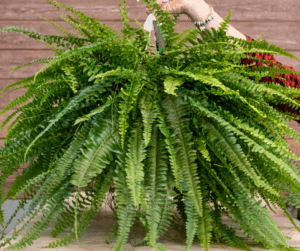
With its lush, feathery fronds, the Boston Fern brings a touch of natural softness and texture to indoor spaces.
Air-Purifying Capabilities: Boston Ferns are effective at filtering out formaldehyde and xylene. They are also known for their ability to increase humidity.
Other Benefits: Their lush foliage adds a vibrant and refreshing feel to interiors. They are relatively easy to care for if their specific needs are met.
Care Guide: Boston Ferns prefer bright, indirect light and consistently moist soil. They also thrive in high humidity, so regular misting or placement in a humid area is beneficial.
Potential Downsides: Non-toxic to pets but can be a bit more demanding in terms of care, particularly regarding humidity.
Urban Planters’ Touch: Boston Ferns look fantastic in hanging baskets or on plant stands, their feathery fronds creating a soft and inviting atmosphere. Their air-purifying and humidity-boosting qualities can contribute to a more comfortable indoor environment.
Bamboo Palm (Chamaedorea seifrizii)
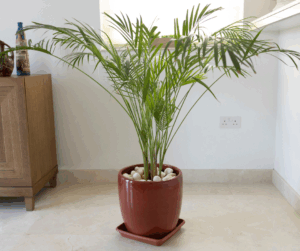
With its delicate, feathery fronds, the Bamboo Palm brings a touch of tropical elegance to indoor settings.
Air-Purifying Capabilities: Bamboo Palms are effective at filtering out formaldehyde, benzene, and trichloroethylene. They are also known for their ability to increase humidity.
Other Benefits: These palms are relatively low-maintenance and can tolerate low light conditions, though they prefer bright, indirect light. Their graceful foliage adds a touch of natural beauty to interiors.
Care Guide: Bamboo Palms prefer bright, indirect light but can tolerate low light. Keep the soil consistently moist but not waterlogged. They appreciate higher humidity.
Potential Downsides: Non-toxic to pets.
Urban Planters’ Touch: Bamboo Palms are a versatile choice for adding a touch of greenery to various office environments. Their air-purifying and humidity-boosting qualities contribute to a healthier and more comfortable workspace.
Aloe Vera (Aloe barbadensis miller)
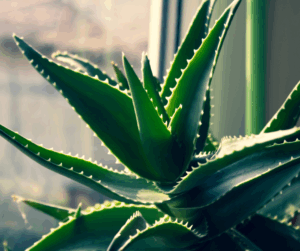
While often celebrated for its medicinal properties, Aloe Vera also offers air-purifying benefits.
Air-Purifying Capabilities: Aloe Vera is effective at filtering out formaldehyde and benzene. It’s a multi-functional plant for a healthy indoor environment.
Other Benefits: The gel inside its leaves has numerous soothing and healing properties for skin. It’s also relatively easy to care for.
Care Guide: Aloe Vera thrives in bright, indirect light and well-draining soil. Allow the soil to dry out completely between waterings to prevent root rot. 1
Potential Downsides: Mildly toxic if ingested.
Urban Planters’ Touch: Aloe Vera’s architectural form and dual benefits make it a practical and stylish addition to office spaces, particularly in areas with good natural light.
By incorporating these air-purifying powerhouses into your commercial space, you can not only enhance its aesthetic appeal but also contribute to a healthier and more productive environment. At Urban Planters, we can help you select the perfect plants for your specific needs and provide ongoing care to ensure they thrive.